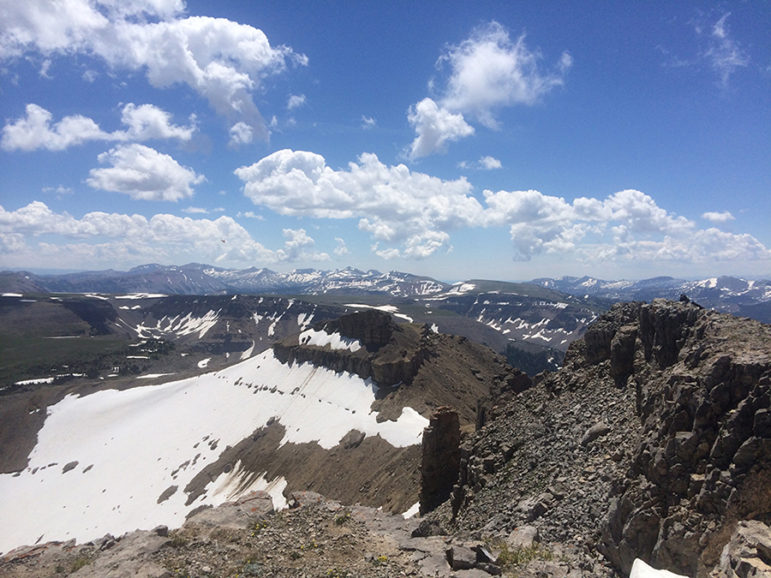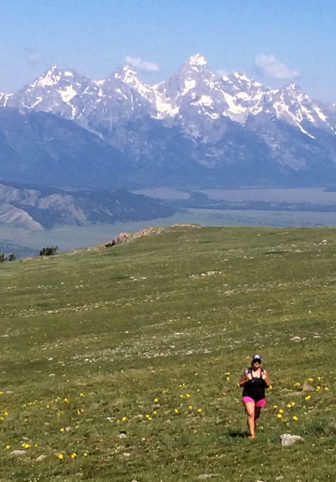
The vantage point of Sheep Mountain in Jackson Hole provides great views of the Tetons.
In the summer there are few places I’d rather be than in the Tetons. I am not talking about in Jackson, Wyo., or along the road, but actually in the heart of the mountains, traveling the canyons away from the crowds and making my way to the tops of the peaks. So I think I surprised my hiking companion on a recent visit to the area when I agreed to a hike outside the park.
The Grand Teton often dominates photos of Jackson’s skyline. But Sheep Mountain, more commonly known as the Sleeping Indian because of the naturally-carved headdress, distinct nose and belly the mountain forms, is Jackson’s second most recognizable peak.
“It’s an iconic peak that kind of defines and watches over Jackson Hole,” said Linda Merigliano, recreation and wilderness program manager with the Bridger-Teton National Forest.
While you need to be in decent physical condition and comfortable traveling in the mountains — think basic route-finding and scrambling — you don’t need technical climbing skills to reach the summit. There you can fully take in the grandeur of the Tetons across the valley. You’ll likely have the views all to yourself because Grand Teton National Park draws most visitors in the area. Those who hike the Sleeping Indian are usually locals that know the area well.
“They are looking for a quieter experience and a little more adventure,” Merigliano said.

The Tetons loom in the background as hiker Cara Rank walks through a grassy meadow on Sheep Mountain in Jackson Hole.
The adventure begins with the drive. We headed down the Elk Refuge Road staying straight past the turnoff to Curtis Canyon. The road gets gnarly for about the last mile, and while you might not need four-wheel drive, you’ll want something high clearance. We parked at the bottom of the hill, where the road turns into a 2-track. It was faster and less stressful to walk up the hill (about a quarter of a mile) to the start of the trail.
It’s about six miles and more than 4,000-feet to the 11,239-foot summit. We felt the burn almost as soon as we started. My suspicion I was out of shape was immediately confirmed. Luckily our frequent stops to wipe sweat out of our eyes and catch our breath also allowed us to take in the fields of wildflowers and the stunning views of the Tetons.
The big snow this year left the mountain lush and vibrant with purple, orange and electric blue flowers. Short flat stretches offered a little reprieve from the upward slog. While the sun beat down on us in the meadows we found enough shade for regular breaks and to let another party pass. We’d pass another party near the summit and see one more group on our way down. Other than that, the trail was quiet — except for our labored breathing.
There are two ways to get to the top of the Sleeping Indian. The route we chose, while popular, is not part of the actual Forest Service trail system, Merigliano warned. That means there are no signs and the trail isn’t maintained. Most of the time the trail is obvious, but on the summit push you follow cairns, and people can get confused coming down the slope. It’s important to pay attention to landmarks and your route going up, Merigliano said. Ideally, on your first hike of the mountain, you should go with someone who has done the hike before.
Merigliano prefers to direct people to the route from the Grizzly Lake Trailhead off the Gros Ventre Road. While slightly longer — about 8 miles each way to the summit — the trip can be made into a beautiful backpacking excursion with an overnight at Blue Miner Lake, about 6.5 miles from the trailhead. It’s a trip I did my first summer in Jackson, and it’s still one of my favorites. The trail to the lake is well-marked and maintained, and Blue Miner is stunning.
For those who want the quicker climb and take the route from the Elk Refuge, Merigliano encourages people to leave their dogs at home, or at least keep them on a leash. The area is important bighorn sheep habitat — the mountain is named after the animals that call it home, and Wyoming’s bighorn sheep face a tenuous future. The less they are disturbed, the better, she said.
Whichever way you tackle the peak, you’ll enter the Gros Ventre Wilderness. This year marks the 50th anniversary of the Wilderness Act and the 30th anniversary of the Wyoming Wilderness Act, which created the Gros Ventre Wilderness.
“It’s a great time to reflect on wilderness and that sense of remembering the mountains are there and that wild country helps define the character what Jackson Hole is,” Merigliano said.
For me the hike provided time to think about Wyoming’s vast and diverse beauty. From the summit you can see the Tetons, but also the red hills of the Gros Ventre Mountains and the granite of the Wind River Mountains, as well as others. It was a reminder that sometimes the best views aren’t always the most obvious ones. Sometimes you need to step back and take in the full picture to truly appreciate something.
For more information on hiking Sheep Mountain, or in the Gros Ventre Wilderness, check in with the Bridger-Teton National Forest at 307-739-5500.
Reprinted with permission from “Peaks to Plains” a WyoFile blog focusing on Wyoming’s outdoors and communities. Kelsey Dayton is a freelancer and the editor of Outdoors Unlimited, the magazine of the Outdoor Writers Association of America. She has worked as a reporter for the Gillette News-Record, Jackson Hole News&Guide and the Casper Star Tribune. Contact Kelsey at kelsey.dayton@gmail.com and follow her on Twitter: @Kelsey_Dayton.

we may want to do this hike.